
Home
Family
History
Coat of Arms
Military History
Lithuanian History
Shenandoah History
Image Galleries
Map Room
Scrapbook
Links
|
Popalis Family History

Dorsey, Jimmy [James]
(Shenandoah, PA, 29 Feb 1904 - New York, 12 June 1957)
Clarinetist, saxophonist, and dance-band leader, brother of Tommy Dorsey

He began playing slide trumpet and cornet at the age of seven, but changed to reed instruments in 1915. With his brother Tommy he led Dorsey's Novelty Six and Dorsey's Wild Canaries, then in the early 1920s performed with the Scranton Sirens. In September 1924 Jimmy joined the California Ramblers, a very popular dance band in New York. Between 1925 and 1934 he worked as a freelance with leading New York bands such as those of Paul Whiteman, Jean Goldkette, and Vincent Lopez. More importantly, from 1926 he began recording extensively with leading midwestern white jazz pioneers, including Bix Beiderbecke and Red Nichols. He played in Nichols's popular group the Five Pennies, a widely influential band not only in the USA but also in England; this established Dorsey as a leading jazz reed player. In 1934 Dorsey founded with his brother the successful but short-lived Dorsey Brothers Orchestra. After a public argument in 1935 Jimmy took over the leadership of the group, building it into one of the leading dance bands of the late 1930s and early 1940s. He appeared with the group in several films, including The Fabulous Dorseys (1947), a fictionalized version of the brothers' careers. He continued to lead dance bands sporadically after World War II until his death, at one period joining Tommy to run a new Dorsey Brothers Orchestra (1953-6). Because Dorsey led one of the most popular dance bands of the swing era and scored novelty hits such as Oodles of Noodles (1932), his importance as a jazz player has been neglected; yet in the 1920s he was a major model for other jazz musicians, both on clarinet and saxophone. Lester Young and Coleman Hawkins both acknowledged his influence. Like many of his contemporaries, Dorsey was attracted to jazz by the examples of the white musicians Larry Shields and Leon Roppolo, but by the late 1920s he came under the influence of the black player Jimmie Noone. Dorsey had an excellent technique and played in a fluid, polished style which could be strongly rhythmic. He can safely be placed among the finest jazz players of reed instruments during the period 1925 to 1935. (See Saxophone, The alto saxophone.) Selected Recordings As leader: St. Louis Blues (1930, Decca F6142); Oodles of Noodles (1932, Columbia 36063); Amapola (1941, Decca 3629); Green Eyes (1941, Decca 3698) As sideman: R. Nichols: Alabama Stomp/Hurricane (1927, Brunswick 3550) Bibliography E. Edwards, Jr., G. Hall, and B. Korst: Jimmy Dorsey and his Orchestra (Whittier, CA, 1966) [discography] G. T. Simon: The Big Bands (New York, 1967, revised and enlarged 2/1971, revised 3/1974, 4/1981) H. Sanford: Tommy and Jimmy: the Dorsey Years (New Rochelle, NY, 1972) C. Garrod: Jimmy Dorsey and his Orchestra (Zephyrhills, FL, 1980) [discography]
James Lincoln Collier
The New Grove Dictionary of Jazz, ? Macmillan Reference Ltd 1988
Copyright © 2000 - 2014 by Andrew J. Popalis
All Rights Reserved
Privacy Policy
|